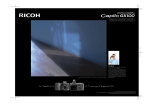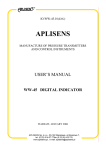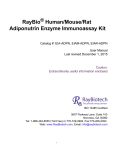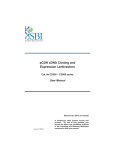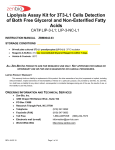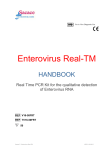Download GPDH Activity Assay - B-Bridge International, Inc.
Transcript
B-Bridge International, Inc. GPDH Activity Assay Measure glycerol-3-phosphate dehydrogenase in precursor adipocytes Catalog # PMC-AK01-COS For research use only Not for diagnostic use V121213 GPDH Activity Assay Table of Contents Purpose……………………………………………………………………………………………………...3 Introduction…………………………………………………………………………………………….……3 Components………………………………………………………………………………………………...4 Additional Materials………………………………………………………………………………………...4 Protocol……………………………………………………………………………………………………...4 Application notes…………………………………………...……………………………………………....6 References…………………………………………...……………………………………………………....6 Notice to Purchaser This product is to be used for Research Purposes Only. It is not to be used for Drug or Diagnostic Purposes, nor is it intended for Human Use. B-Bridge products may not be resold, modified for resale, or used to manufacture commercial products without the express written consent of B-Bridge International, Inc. EXCEPT AS OTHERWISE EXPRESSLY SET FORTH IN THIS USER MANUAL, B-BRIDGE DOES NOT MAKE ANY REPRESENTATION OR WARRANTIES OR CONDITIONS OF ANY KIND, EITHER EXPRESS OR IMPLIED, WITH RESPECT TO THE PRODUCTS, OR INFORMATION DISCLOSED HEREUNDER, INCLUDING, BUT NOT LIMITED TO, THE IMPLIED WARRANTIES OF MERCHANTABILITY, FIT FOR A PARTICULAR PURPOSE, OR NONINFRINGEMENT OF THE INTELLECTUAL PROPERTY RIGHTS OF THIRD PARTIES. 2007, B-Bridge International, Inc. B-Bridge International, Inc. www.b-bridge.com 2 All Rights Reserved. V121213 GPDH Activity Assay Purpose GPDH Activity Assay is a quantitative colorimetric measurement of glycerol-3-phosphate dehydrogenase (GPDH) activity in cell cultures and tissue samples such as adipocytes and adipose tissues. Introduction An organism’s major sources of fatty acids come from its diet or mobilization from cellular storage. Fatty acids from the diet are solubilized and absorbed through the gut and delivered to cells via blood transport. Excess free state long chain fatty acids are cytotoxic in cells. Adipocytes avoid the accumulation of fatty acids by storing it in the form of triacylglycerols. In adipose tissue, GPDH reduces dihydroxyactone phosphate (DHAP) to glycerol 3-phosphate using coenzyme NAD. The sequential binding of three glycerol 3-phosphates by coenzyme acyl-CoA generates triacylglycerol. In response to energy demands, the fatty acids stored as triacylglycerols can be utilized by peripheral tissues. NADH NAD Glycerol-3-phosphate Dihydroxyacetone phosphate GPDH The measurement of GPDH activity is often used as a marker for lipogenesis (biosynthesis of fat). The activity of GPDH rapidly increases upon differentiation of precursor adipocytes to mature adipocytes. The GPDH Activity Assay is a rapid and easy to use assay to quantify GPDH in cultured cells or tissue samples. When exogenous DHAP and NADH are mixed with the test sample, glycerol 3-phosphate and NAD will be produced, if the sample contains GPDH activity. GPDH activity is measured by the decrease concentration of NADH. B-Bridge International, Inc. www.b-bridge.com 3 V121213 GPDH Activity Assay Components Kit components can be stored at -20°C prior to use • • Substrate Solution containing DHAP and NADH, lyophilized………………………..10 bottles Enzyme Extraction Reagent, powder….……………………………………………….1 bag 1 kit = 100 tests Additional materials and equipment may be required • • • • • • • • Distilled water Pipette PBS Spectrophotometer with 340 nm wavelength Quartz microcuvette Centrifuge Centrifuge tubes Sonicator Protocol I. Reagent preparation and storage Prepare and store reagents at 4°C 1. Reconstitute the lyophilized Substrate Solution in 4.2 ml purified water per bottle. The solution is stable for 2 days at 4°C. Only reconstitute the number of bottles that will be used immediately. 2. Dissolve the Enzyme Extraction Reagent in 200 ml distilled water. The solution is stable for 4 weeks at 4°C. Note: Do not mix reagents from different kits unless they have the same lot number. II. Sample Preparation Samples should be prepared and maintained at 4°C 1. Tissue sample i. Homogenize 1 g of adipose tissue in 4 ml of 0.25M sucrose ii. Centrifuged at 700 x g for 10 minutes at 4°C iii. If a fat layer forms on the surface of the sample, carefully remove the fat layer. iv. Transfer the supernatant (cytosol fraction) to a tube and dilute 20 to 100 times with the Enzyme Extraction Reagent, then assay samples. 2. Culture cells i. Remove culture medium and wash the cells 2 times with 500ul PBS. ii. Add Enzyme Extraction Reagent to each well. For a 24-well plate, use 0.5 – 1 ml per well. iii. Scrape cells with a sterile rubber policeman. Transfer cells to a clean centrifuge tube B-Bridge International, Inc. www.b-bridge.com 4 V121213 GPDH Activity Assay iv. Using a sonicator, homogenize the cell extracts v. Crude extracts may be directly assayed or centrifuged at 12,800 x g for 5 minutes at 4°C. Centrifugation is recommended. vi. Assay the sample supernatant III. Assay Procedure 1. Add 400 µl of resuspended Substrate Solution to a quartz microcuvette. Bring the solution to room temperature. If the spectrophotometer has an incubator, incubate 5 minutes at 25°C. 2. Allow samples to equilibrate to room temperature 3. Add 200 µl of sample to the cuvette containing the Substrate Solution. Mix well. 4. Use the kinetic analysis mode of the spectrophotometer or manually measure OD340nm starting at time 0 and every 30 seconds for 3 minutes. Alternative: 24-well and 96-well plate format 1. Add 800 µl Substrate Solution per well (24-well) or 80 µl per well (96-well). Bring the solution to room temperature. 2. Allow samples to equilibrate to room temperature 3. Add 400 µl of sample per well (24-well) or 40 µl per well (96-well). Gently mix, do not create bubbles. 4. Use the kinetic analysis mode of the spectrophotometer or manually measure OD340nm starting at time 0 and every 30 seconds for 3 minutes. IV. Calculation of GPDH activity 1. Plot OD340nm against time 2. Using the linear range of the graph, select 2 time points that are 1 minute apart (i.e. time points 60 and 120 seconds) to calculate ∆OD340nm/min GPDH activity (U/ml) = OD340nm/min x A 6.22 x B x C A (ml) = Total reaction volume 6.22 = Millimolar absorption coefficient of NADH molecules B (ml) = Sample volume assayed C (cm) = Optical path length If followed dilutions in Section III, A= 600 ml B= 200 ml C = 1 cm If using a microplate then, C= Sample volume in the well (ml) Bottom surface area of well (cm2) 3. 1 Unit of GPDH activity is defined as 1 ml of sample consumes 1 µmole of NADH in 1 minute (light path = 1cm). B-Bridge International, Inc. www.b-bridge.com 5 V121213 GPDH Activity Assay Application Notes for cultured adipocytes Primary culture from adipose tissue or cell lines (i.e. 3T3-L1, 3T3-f442, ob1771) Culture medium: 1. Basal Medium: DMEM containing high concentration of glucose (4.50 g/l high glucose) with 10%FBS 2. Differentiation Medium: Basal medium + 0.25 µM Dexamethazone and 10 µg/ml Insulin Culture protocol: 1. Plate cells at 0.5 – 1 X 105 cells/well in a 24-well plate. It takes approximately 1-2 days for cells to become confluent 2. Once culture is confluent, replace the Basal Medium with the Differentiation Medium 3. Incubate for 2 days 4. Replace the medium with Basal Medium 5. Add test compounds, such as inhibitors and inducers for lipid accumulation 6. Incubate 5 - 10 days until lipid accumulates in the cells 7. Wash cells 2 times using PBS 8. Add 0.5 – 1 ml Enzyme Extraction Solution to each well 9. Remove cells with a rubber policeman and place the cells in a tube 10. Sonicate cells on ice 11. Perform GPDH assay on the extract. Example Data GPDH Activity 0.08 1.4 1.2 1.0 0.8 0.6 0.4 0.2 0 0.07 A B C Blank 0 V. GPDH (U/mg DNA) OD 340 nm Decrease in OD with each compound added 0.06 0.05 0.04 0.03 0.02 0.01 0 30 60 90 120 150 180 Time Time (sec) (sec) A B C References 1. Tashiro, K., Inamura, M., Kawabata, K., Sakurai, F., Yamanishi, K., Hayakawa, T., Mizuguchi, H. Efficient Adipocyte and Osteoblast Differentiation from Mouse Induced Pluripotent Stem Cells by Adenoviral Transduction. Stem Cells. 27, 1802-1811 (2009) 2. Nagane, K., Jo, J., Tabata, Y. Promoted Adipogenesis of Rat Mesenchymal Stem Cells by Transfection of Small Interfering RNA Complexed with a Cationized Dextran. Tissue Eng. Part A. 16, 21-31(2010) B-Bridge International, Inc. www.b-bridge.com 6 V121213 GPDH Activity Assay 3. Matsumura, K., Bae,JY., Hyon SH. Polyampholytes as Cryoprotective Agents for Mammalian Cell Cryopreservation. Cell Transplant. 19, 691-699 (2010) 4. Jiao, WH., Gao, H., Li, CY., Zhou, GX., Kitanaka, S., Ohmurae, A., Yao, XS. beta-Carboline Alkaloids from The Stems of Picrasma quassioides. Magn. Reson. Chem. 48, 490-495 (2010) 5. Kozak, L.P., and Jensen, J.T. (1974) J Biol Chem 249, 7775-7781 6. Wise, L., and Green, H. (1979) J Biol Chem 254, 273-275 For assistance and ordering please contact : B-Bridge International, Inc. 20813 Stevens Creek Blvd, Suite 200 Cupertino, CA 95014 USA Tel: 408-252-6200 Fax: 408-252-6220 Email: [email protected] www.b-bridge.com B-Bridge International, Inc. www.b-bridge.com 7 V121213








